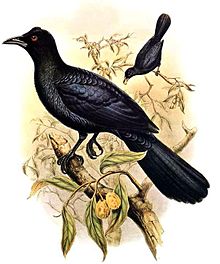Jobi Paradise Crow
| Jobi Paradise Crow | ||||||||||||
|---|---|---|---|---|---|---|---|---|---|---|---|---|
| Systematics | ||||||||||||
|
||||||||||||
| Scientific name | ||||||||||||
| Manucodia jobiensis | ||||||||||||
| Salvadori , 1876 |
The Jobi paradise crow ( Manucodia jobiensis ), also called Jobi-Manucodia , is a crow - like -looking bird from the family of the birds of paradise (Paradisaeidae). It is considered a secret bird species that has so far only been little studied. The Jobi Paradise Crow occurs in New Guinea and neighboring islands. The species belongs to the few monogamous species of the birds of paradise.
The IUCN classifies the population of Jobiparadiescrahe as harmless ( least concern ). No subspecies are distinguished.
description
Body type and measurements
The Jobiparadiescrahe is within the genus of the Manukoden a comparatively small bird of paradise with a stepped tail plumage.
It reaches a body length of up to 34 centimeters, of which between 11.3 and 14.1 centimeters in males and between 11.7 and 12 centimeters in females are due to the control springs . The beak has a length of 3.5 to 4.2 centimeters. The males weigh between 212 and 257 grams, the females are slightly lighter at 150 to 205 grams. The sexes differ only slightly. The females are usually slightly smaller than the males.
Appearance
The head and the neck are black-blue and with strongly metallic blue-green shiny feather tips. Under certain lighting conditions, these can also shine purple. On the neck, chin, throat and neck, these shiny feather tips, which stand out against the otherwise matt blue-black plumage, make the plumage appear slightly banded. The coat, the back, the rump and the top of the tail plumage are dark blue with an intense, metallic purple sheen. Under certain lighting conditions this is also a magnet. The shine is missing here on the feather tips, so that with certain incidence of light the feathers also appear cross-banded.
The metallic sheen is less pronounced on the chest than on the coat and the sheen is even less intense on the stomach and thighs. The plumage also shimmers rather bluish-green. The beak is black with a slightly broadened ridge of the beak. The iris is blood red. The legs and feet are black.
Possible confusion

The Jobi paradise crow can hardly be distinguished from the green paradise crow when observing the fields . Compared to this species, it only has a slightly shorter tail, which is also slightly less stepped than is the case with the other species of Manukodes .
Distribution area and habitat
The main distribution area of the Jobi Paradise Crows are the lowlands in the northern half of New Guinea . However, the distribution area is also disjoint here . It stretches from Cenderawasih Bay to the mouth of the Ramus . In the southern half of New Guinea, the range is limited to small areas in the west between the Mimika and Setekwa rivers. The Job Paradise crow also inhabits the island of Yapen , a 2,278 km² island in the Cenderawasih Bay. The altitude distribution ranges from the lowlands of New Guinea to altitudes of 500 meters. It is only very rarely found at altitudes of 750 meters; Usually the green paradise crow occupies its ecological niche above 500 meters. However, there are few areas in which both Jobi- and gloss paradise crows , sound occur and green paradise crow.
The habitat of the Jobi paradise crows are rainforests of the lowlands, swamp forests and forest edges in the foothills.
Way of life
So far, the Jobi Paradise crow could only be seen eating fruit. However, it is assumed that it also eats invertebrates. It is often associated with other bird species when foraging for food. It is noticeable that these are birds whose plumage is predominantly black or brown.
Like all other Manukodes, the Jobi paradise crow is monogamous. However, little research has been done on reproductive biology. The only known nest was 2.4 meters above the ground and hung between two horizontal branches. It was built from roots, parts of creepers and leaves. The only known clutch consisted of two pale pink eggs. The egg shell also had small dark brown and lavender gray spots.
literature
- Bruce M. Beehler , Thane K. Pratt: Birds of New Guinea; Distribution, Taxonomy, and Systematics . Princeton University Press, Princeton 2016, ISBN 978-0-691-16424-3 .
- Clifford B. Frith, Bruce M. Beehler : The Birds of Paradise - Paradisaeidae . Oxford University Press, Oxford 1998, ISBN 0-19-854853-2 .
Individual evidence
- ↑ Handbook of the Birds of the World on Jobiparadiescrows , accessed July 8, 2017
- ↑ a b c Frith & Beehler: The Birds of Paradise - Paradisaeidae . P. 217.
- ↑ Frith & Beehler: The Birds of Paradise - Paradisaeidae . P. 219.
- ↑ a b Frith & Beehler: The Birds of Paradise - Paradisaeidae . P. 218.
- ↑ Frith & Beehler: The Birds of Paradise - Paradisaeidae . P. 220.